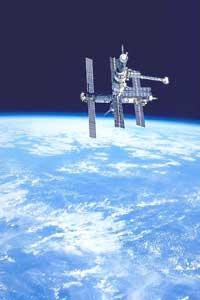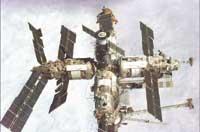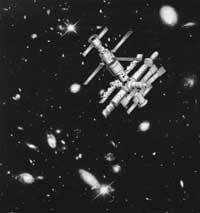MIR: fifteen years in space
2001/02/01 Urresti, Igor - Elhuyar Zientziaren Komunikazioa Iturria: Elhuyar aldizkaria
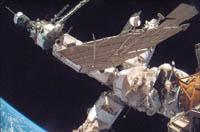
The road to the Soviet permanent space station began in 1964, three and a half years after the launch of the first cosmonaut Juri Gagarin, when General Txelomei decided to build in the company OKB-52 the first orbital space formed by his companions. The station designed for this time was giant: 20 tons of weight and 4.1 m of diameter. The diameter was not chosen at random, as it was the largest size that the train could carry to the shooting station of Baiconur.
The objective was to build a permanent working space in orbit around the Earth, where to carry out scientific and military tests. The program, named Soiuz (unity), began in 1967 with the orbit of the Soiuz 1 ship. Despite the serious problems that the first missions had, first person dead in space, Vladimir Komarov, in 1967, the Soviets gradually developed the technology necessary to work in space. They also competed with the Gemini program that Americans had at that time. Finally, in 1970, in the Soiuz 9 mission the cosmonauts stayed 18 days in space and managed to overcome the 14-day permanence record that Gemini 7 had for five years.
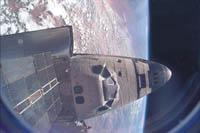
Later, in 1971, came the generation of the first Soviet space stations. The Saliut modules could be with or without people and were equipped with a jam to meet the Soiuz ship. The basis of the idea was clear: keep the Saliut modules in space and use the Soiuz containers to make the journey to land. In the Saliut program there were also many problems at first, especially in the Saliut 2 and 3 missions, but finally Saliut 7 beat all the records of permanence that had until then, since the cosmonauts remained there for eight months.
In 1973 the Americans also tried to develop permanent space stations, but after the Skylab station they decided to reinforce other programs, especially the ferry, leaving the project aside.
Finally, on February 19, 1986, the Soviets put the Mir space station into orbit. The station designed for three or four years has been working for 15 years!
Structure of Mir station
In fact, the Mir station is a modular and complex structure of several interconnected modules. The main body Mir in has gradually incorporated specialized modules that offer suitable spaces for the realization of trials in different fields of science.
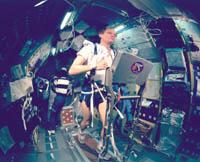
The Mir module was the first to be put into orbit and is the main module of the station. It has a length of 13 meters and a diameter of 4.1 m. It has six access gates from other modules. Two jams on the main axle, front and rear, and another four lateral, separated 90º.
In the module Mir (peace in the Russians) is the area of operation and residence. The point of operation is the control point of the Mir complex. From here they control the operation of the system and pilot the station. In addition, there is a place for scientific trials. In the residential area, in addition to a table, a garbage storage system and a kitchen, each cosmonaut has his own sleeping cabin.
The Kvant-1 module joined the main module in 1987 and is used for astrophysics. Get information about galaxies, quasars, and neutron stars by measuring the electromagnetic spectrum and X-ray emissions.
The Kvant-2 module (1989) specialises in biotechnology research and earth observation. It also has an outdoor lock that is used to analyze the behavior of materials and electronic systems in space.
The Kristall technology module (1990) is an area of material processing in the space environment. It has equipment for the production of semiconductors and other materials by microgravity. Among other things, there is also the greenhouse to study agriculture without gravity.
The Spektr module was sent to space in 1995 and has equipment for the study of the atmosphere and natural resources of the soil.
The Priroda module was the last module to be added to the complex in 1996. In the atmosphere it has radiometers, radars and spectometers to measure the concentration of ozone and aerosols.
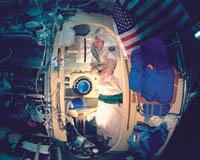
All the modules of the Mir complex have floors, walls and differentiated ceilings -floor with carpets, walls with colors and white ceiling with fluorescent-. Although in microgravity the upper and lower parts make no sense, this organization gives cosmonauts a touch of normality.
The Soiuz-TM module is used to send the cosmonauts to Mir station and return to the ground after the stay, while the Progress-M spacecraft is used to supply fuel and scientific equipment to the station. The Progress-M container is fully automatic and used to bring garbage from the station back to Earth.
Contribution Mir in
More than 20,000 trials in Mir. In order to obtain reliable and satisfactory results, the presence of people in order to analyze the evolution of the trial and make decisions and change something depending on it is essential to carry out several trials. In it birds in microgravity were born for the first time and we were able to follow the evolution of the embryos of amphibians. No wonderful discoveries have been made, but undoubtedly this station has long offered a great opportunity to make observations and studies in space.
On the other hand, Mir has been very useful to see the conditions and limitations in which the human being lives and works in space. In 1988, the Soviets had two consecutive cosmonauts for a year at the station. The optimal duration of the stay is six months. Cosmonauts need the first month to get used to the situation of weightlessness, especially to move comfortably and perform the work with tranquility.
It has been proven that the human body adapts quite well to microgravity. In the first couple of weeks cosmonauts usually have nausea, but then the body gets used to this new blood distribution and feels comfortable. Muscle strength and bone resistance are not necessary, so they are weakening and is one of the problems. And is that by the time the cosmonaut returns to the ground has to take care of his physical state, and despite exercising for a couple of hours a day, after six months the consequences begin to be serious. This would be a major obstacle to possible interplanetary journeys that could last for years. In addition, from six months, the cosmonaut gets nostalgia and productivity decreases considerably.
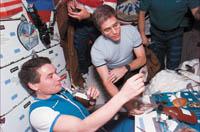
But perhaps Mir's greatest benefit is openness to international cooperation in space. Since 1993, Russians travel by American ferries and Americans have made long stays in Mir. In the same Mir they have been astronauts from 15 different states. All this has given way to an international space station in operation. An invaluable collaboration that has contributed to maintaining relations between both powers.
The information collected in Mir has served to design the structure of the new station and is intended to use a large number of solutions used in Mir: stabilization system and balanced station in space, fuel and electricity system, automatic Progress supply cuvette, etc. The main module of the international station will also be the Russian module Zveda.
The challenge that Mir left after is not easy. Will the new international station take with force the witness left by old Mir?
MirCorp: Seeking sources of private income to ensure the survival of the Views
The market economy has also reached space. Telecommunications satellites, trials for pharmaceutical research or the possibilities of producing new materials have also brought space to a market economy.
Mir has also had his last chance at private sources. The Russian space company Energía, which manages Mir, and the Dutch private company Gold Apple, founded the company MirCorp.
Behind MirCorp are several entrepreneurs who have made a fortune in telecommunications, especially American Walt Anderson and Indian Txirinjev Katuria, a global internet entrepreneur.
Anderson says that "Mir is obsolete and has problems, but we don't throw old buildings when they have problems in the heating system. The house is renewed"
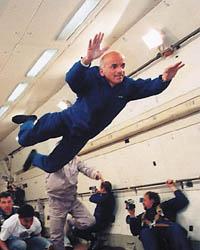
His goal was to keep Mir station two more years. First, they needed to send the mission to carry out some repairs. Thus, on April 6, 2000, two cosmonauts were sent to repair the microleaks and perform the rest of the necessary repairs. In the same month, the Progress-M fuel-loaded vessel was sent, paid by private sources. The cosmonauts remained in space for two months and were used for various trials. It was the first space mission paid with private money.
But the most striking novelty of MirCorp has been the possibility of expanding the space for tourism. Dennis Tito, an American millionaire, has been the first to be willing to travel into space. He was willing to pay $20 million and also did training exercises in the "city of stars". J. Director of the film Titanic Cameron also set out to travel in Mir.
Another preparation was actor Vladimir Stelkov. Stelkov was elected actor for the film "The Last Journey" that he was going to shoot in Mir. Also interested was Mark Bennet, creator of the contest Survivors (Survivor), with great television success, and the US channel NBC put on the table $ 40 million. In this program, called "Mir Goal", a dozen competitors would prepare to go to the space and Russian officers would disqualify a competitor weekly. The prize consists of a trip to Mir station.
But MirCorp had to raise about $125 million to continue with people in space. The funds to be paid in December did not arrive on time and, finally, the technical problems of Mir have forced to suspend the project.

Gai honi buruzko eduki gehiago
Elhuyarrek garatutako teknologia




